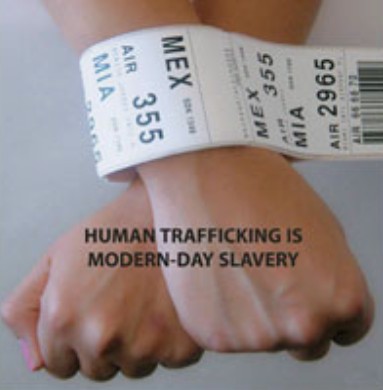guest |
October 18th, 2012
Today is Anti-Slavery Day, a day to raise awareness of modern day slavery and to inspire people to eliminate it. The transatlantic slave trade was abolished and outlawed in 1807 and slavery is internationally prohibited in the Universal Declaration of Human Rights. However, there is still an estimate of 12.3 million people worldwide forced to work for little or no pay.
The transatlantic slave trade was abolished and outlawed in 1807 and slavery is internationally prohibited in the Universal Declaration of Human Rights. However, there is still an estimate of 12.3 million people worldwide forced to work for little or no pay.
Bonded labour is the least well-known, yet the most common form of modern slavery. Bonded labour, or debt bondage, means that a person’s labour is demanded as a means for repayment for a loan. A bonded labourer often works for no pay, seven days a week. Bonded labour is sometimes passed on for generations and may involve entire families. It is most common in South-Asia, in cottage industries and in factories, but it can also be found in parts of Africa, the Caribbean, and South-East Asia.
Other forms of modern day slavery are forced marriage, child labour, forced labour, slavery by descent, and human trafficking.
Read more.. »
guest |
October 17th, 2012
“Wherever men and women are condemned to live in extreme poverty, human rights are violated. To come together to ensure that these rights be respected is our solemn duty.” Joseph Wresinski, the founder of ADT Fourth World
Today is the International Day for the Eradication of Poverty. Nearly half of the world’s population (that’s three billion people) live on less than $2.5 a day. 1.1 billion people have inadequate access to water and 2.6 billion people live without basic sanitation. Approximately 790 million people in the developing world are still chronically undernourished, almost two-thirds of them residing in Asia and the Pacific. 18 million deaths a year, one third of the world’s deaths, are caused by poverty.
Nearly half of the world’s population (that’s three billion people) live on less than $2.5 a day. 1.1 billion people have inadequate access to water and 2.6 billion people live without basic sanitation. Approximately 790 million people in the developing world are still chronically undernourished, almost two-thirds of them residing in Asia and the Pacific. 18 million deaths a year, one third of the world’s deaths, are caused by poverty.
All the more shockingly, an average cow in the European Union receives more than £1.40 a day in subsidies, which is more than the amount that half the world’s population survives on.
This year’s theme for International Day for the Eradication of Poverty is “Ending the Violence of Extreme Poverty: Promoting Empowerment and Building Peace.” Just like the quote above by Joseph Wresinski, this theme recognizes poverty as a human rights violation, rather than simply as a low income level.
Read more.. »
guest |
October 16th, 2012
Navaratri, one of the greatest Hindu festivals, begins today. Navaratri means ‘nine nights’ in Sanskri. The celebration symbolises the triumph of good over evil and the festivities last for nine days. Navratri takes place at the beginning of October around harvest time.
Navaratri means ‘nine nights’ in Sanskri. The celebration symbolises the triumph of good over evil and the festivities last for nine days. Navratri takes place at the beginning of October around harvest time.
Most Hindus fast during Navaratri and only have a single meal during the day. Despite the fast, food is very important in Navaratri and there are many special Navaratri dishes such as banana chips and aloo raita. Fruits and dairy dishes are very popular, whereas non-vegetarian food is totally avoided during the celebrations. The internet offers several Navartri food and cooking guides. For this year’s Navaratri, India Today suggests a range of “mouth-watering twists” to tradition recipes, that will turn the “fast into a feast.”
Read more.. »
guest |
October 16th, 2012
Today is World Food Day, a day to honor the founding of the Food and Agriculture Organization of the United Nations in 1945.

1.5 billion live on less than $1 a day
World Food Day is a day to consider questions such as: is there enough food for everybody? Why do people go hungry? Are we eating too much? Are we eating too much meat? What is sustainable farming? What is genetically manipulated food?
Food is a basic human right but nearly one in six people around the world do not have enough food to be healthy and to live an active life. Approximately 1.5 billion people live on less than US $1 a day and every 3.6 seconds someone dies of hunger.
The Food and Agriculture Organisation states that hunger is “the most critical manifestation of poverty,” and hunger, “undermines the peace and prosperity of nations and traps individuals in a vicious cycle of poor nutrition, ill health and diminished capacity for learning and work that is passed on from one generation to the next.”
Former Head of the Food and Agriculture Organization, Dr Jacques Diouf, speaks of the connection of hunger and poverty and raises a valid point: “While hunger is a consequence of poverty, the opposite is also true: Hunger causes poverty.”
Read more.. »
guest |
October 15th, 2012
It is estimated that 60% of chronically hungry people are women and girls. Today is International Day of Rural Women, a day that recognizes the vital role of rural women, including indigenous women, in enhancing agricultural and rural development, improving food security and eradicating rural poverty.

60% of chronically hungry people are women.
The day is purposefully held a day before World Food Day in order to highlight the role rural women play in food production.
The International Day of Rural Women was first observed at a significant time in October 2008. 2006, 2007, and 2008 were the years of the global food crisis when prices of staple foods rose dramatically around the world. Although prices declined slightly right afterwards they spiked again in 2010 and have been high since. UN Women Watch writes that food prices are “likely to remain high and volatile over the next decade.”
Poor rural households feel the global crises the hardest. The poorer the household the more its members have to change the way they live to cope with the crises.
Read more.. »
guest |
October 13th, 2012
Today is the International Day for Disaster Reduction (IDDR), a day to encourage every citizen and government to take part in building more disaster resilient communities and nations.

A natural disaster affects everybody.
This year’s theme for IDDR is ‘Women and Girls: The (In)visible Force of Resiliance.’
Margareta Wahlström, a Special Representative of the UN Secretary-General for Disaster Risk Reduction, describes the theme in the following way:
“We know that when women and young girls are involved in planning and decision-making in communities they contribute their fair share to keeping the community safe.
Read more.. »
guest |
October 11th, 2012
Today is the International Day of the Girl Child.
The UN theme this year is ‘Ending Child Marriage.’ According to Choices for Girls campaign by Plan every three seconds, somewhere in the world, a girl is forced into marriage. Child marriage denies a girl of her childhood, disrupts her education, limits opportunities, and increases the possibility of her becoming a victim of violence and abuse. In most developing countries, even the girls who are not forced into marriage have very limited opportunities and are mostly expected to stay at home and do domestic work. Thirteen-year-old girl, Bintou, from Mali tells the ‘Choices for Girls’ campaign that, “I would choose manhood if I could.”
Education is a key factor in eliminating child marriage. Unfortunately, in more than 100 countries around the world school is not free and parents often choose to invest in their son’s education rather than their daughters. According to CNN only 30% of girls worldwide are enrolled in secondary school, and fewer young females are literate.
Read more.. »
guest |
October 11th, 2012
Today is World Sight Day, a day that aims to eliminate avoidable blindness across the globe. Up to 80% of blindness could be treated or prevented. However, since 90% of people with impaired vision live in developing countries treatment is rarely available. Women especially face barriers in receiving adequate eye health care. There are about 285 million people with impaired vision worldwide. 39 million of them are blind, and 246 million have low vision. Approximately 19 million of these people are children.
Up to 80% of blindness could be treated or prevented. However, since 90% of people with impaired vision live in developing countries treatment is rarely available. Women especially face barriers in receiving adequate eye health care. There are about 285 million people with impaired vision worldwide. 39 million of them are blind, and 246 million have low vision. Approximately 19 million of these people are children.
World Sight Day is working together with the World Health Organization on a “Vision 2020: Right to Sight” campaign, a global initiative which includes NGOs, professional associations, and eye care corporations. Vision 2020 was launched in 1999, and the campaign hopes to prevent 100 million people from becoming blind over two decades by eliminating the primary causes of blindness.
guest |
October 9th, 2012
Today is World Postal Day, the anniversary of the Universal Postal Union, and a day to celebrate the role of the postal sector in our every day lives. The date October 9th was declared as World Postal Day in Tokyo in 1969, in the 16th Universal Postal Union Congress.
Historically, postal services meant individuals who travelled large distances either by foot or on horseback, delivering important messages from village to village. Although the role of postal services has dramatically changed in the digital era, the role of postal services is still vital in many remote areas of the world. Even in areas with a high level of access to digital communication, postal services are important for distributing goods bought from online stores.
Read more.. »
guest |
October 5th, 2012
“Take a stand for teachers!” is the slogan for this year’s World Teachers’ Day.

1.7 million teachers are needed for 2015
The aim of the day is to mobilize support for teachers world wide. Taking a stand for the teaching profession means providing adequate training, ongoing professional development, and protection for teachers’ rights.
A quality education offers hope and the promise of a better standard of living across the globe. There can be no quality education without competent and motivated teachers, however, which is why World Teachers’ Day aims to recognize the great efforts of teachers world wide.
Read more.. »
 The transatlantic slave trade was abolished and outlawed in 1807 and slavery is internationally prohibited in the Universal Declaration of Human Rights. However, there is still an estimate of 12.3 million people worldwide forced to work for little or no pay.
The transatlantic slave trade was abolished and outlawed in 1807 and slavery is internationally prohibited in the Universal Declaration of Human Rights. However, there is still an estimate of 12.3 million people worldwide forced to work for little or no pay.

 Nearly half of the world’s population (that’s three billion people) live on less than $2.5 a day. 1.1 billion people have inadequate access to water and 2.6 billion people live without basic sanitation. Approximately 790 million people in the developing world are still chronically undernourished, almost two-thirds of them residing in Asia and the Pacific. 18 million deaths a year, one third of the world’s deaths, are caused by poverty.
Nearly half of the world’s population (that’s three billion people) live on less than $2.5 a day. 1.1 billion people have inadequate access to water and 2.6 billion people live without basic sanitation. Approximately 790 million people in the developing world are still chronically undernourished, almost two-thirds of them residing in Asia and the Pacific. 18 million deaths a year, one third of the world’s deaths, are caused by poverty. Navaratri means ‘nine nights’ in Sanskri. The celebration symbolises the triumph of good over evil and the festivities last for nine days. Navratri takes place at the beginning of October around harvest time.
Navaratri means ‘nine nights’ in Sanskri. The celebration symbolises the triumph of good over evil and the festivities last for nine days. Navratri takes place at the beginning of October around harvest time.



 Up to 80% of blindness could be treated or prevented. However, since 90% of people with impaired vision live in developing countries treatment is rarely available. Women especially face barriers in receiving adequate eye health care. There are about 285 million people with impaired vision worldwide. 39 million of them are blind, and 246 million have low vision. Approximately 19 million of these people are children.
Up to 80% of blindness could be treated or prevented. However, since 90% of people with impaired vision live in developing countries treatment is rarely available. Women especially face barriers in receiving adequate eye health care. There are about 285 million people with impaired vision worldwide. 39 million of them are blind, and 246 million have low vision. Approximately 19 million of these people are children.
 Hello, I'm Deborah Swallow and, for the last fifteen years, I've worked in over thirty countries addressing the complexities of people working internationally across multiple cultures, so individuals and organisations alike can gain an authentic competitive edge and win in international markets.
Hello, I'm Deborah Swallow and, for the last fifteen years, I've worked in over thirty countries addressing the complexities of people working internationally across multiple cultures, so individuals and organisations alike can gain an authentic competitive edge and win in international markets. 